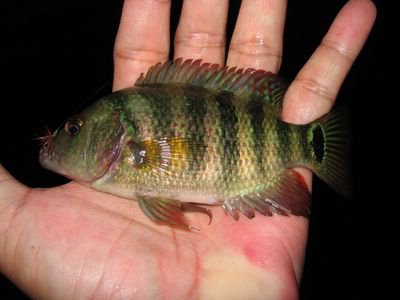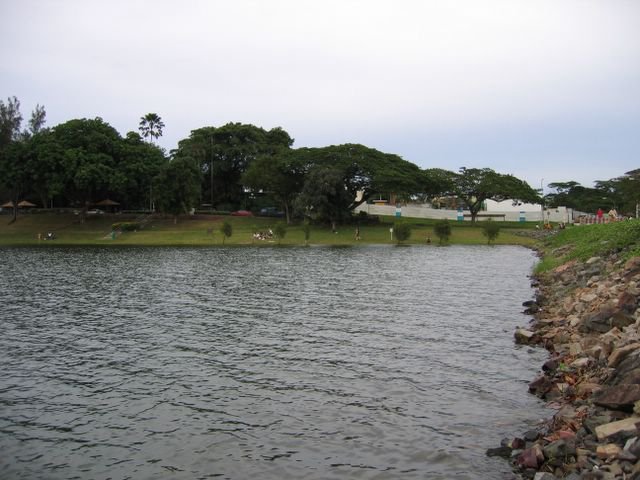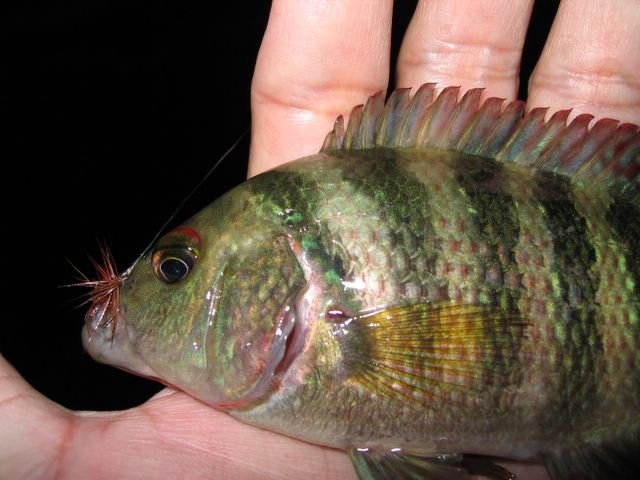 Upper Seletar Reservoir, Mandai Dam
Upper Seletar Reservoir, Mandai Dam
This place was once my favorite hunting ground for giant tomans during my luring days. Now I only target the zebra tilapias, some as big as 1 kilogrammes. But most of the time I was happy to get a few palm size zebras which put up very good “fights”.
Today, I caught a tiny zebra tilapia on a Copper Head Nymph. Weighted flies get to the required depth faster and excite the tilapias. They came out of their hiding place amongst the granites and take quick swipes on the fly.
The next one was caught on an Amphibious Fly. Yes, Amphibious. This fly was tied with a feather which will sink when wet. But it will stay afloat when it is dry. I don’t know what bird the feather belonged to. When I want the fly to stay afloat on the surface, I false cast the fly a few more times before letting it land on the surface. The fly will function as a wet fly if my false cast is two times, three the maximum. But of course the sink rate is rather slow. A roll cast would give the perfect presentation if I want to keep the fly wet. Anyway, it is very effective on tilapias at this part of the dam.

This part of the dam was once a favorite habitat for the giant tomans. They were depleted by the Thai workers. Now it is infested with happy tilapias.
Today, I caught a tiny zebra tilapia on a Copper Head Nymph. Weighted flies get to the required depth faster and excite the tilapias. They came out of their hiding place amongst the granites and take quick swipes on the fly.
The next one was caught on an Amphibious Fly. Yes, Amphibious. This fly was tied with a feather which will sink when wet. But it will stay afloat when it is dry. I don’t know what bird the feather belonged to. When I want the fly to stay afloat on the surface, I false cast the fly a few more times before letting it land on the surface. The fly will function as a wet fly if my false cast is two times, three the maximum. But of course the sink rate is rather slow. A roll cast would give the perfect presentation if I want to keep the fly wet. Anyway, it is very effective on tilapias at this part of the dam.

This part of the dam was once a favorite habitat for the giant tomans. They were depleted by the Thai workers. Now it is infested with happy tilapias.
 Wetting the granite to protect the fish and a dry leave to protect my Baby Marryat fly reel.
Wetting the granite to protect the fish and a dry leave to protect my Baby Marryat fly reel.
 Closer look at the copper head.
Closer look at the copper head.
 A copper head nymph was used to catch this tilapia. Weighted to sink quickly.
A copper head nymph was used to catch this tilapia. Weighted to sink quickly.
 This stretch of the dam is packed with tilapias.
This stretch of the dam is packed with tilapias.
 Holiday fishermen. Mostly using catfish as bait.
Holiday fishermen. Mostly using catfish as bait.
 Nimbostratus clouds.
Nimbostratus clouds.
 Sunset.
Sunset.
 Rain clouds overcasted the sky. Probably will rain tomorrow morning.
Rain clouds overcasted the sky. Probably will rain tomorrow morning.
 Setting sun.
Setting sun.
 The bait fishermen. They fished with catfish for the giant tomans.
The bait fishermen. They fished with catfish for the giant tomans.
 A closer look at the amphibious fly. Yes amphibious fly. Not dry . Not wet. Amphibious.
A closer look at the amphibious fly. Yes amphibious fly. Not dry . Not wet. Amphibious.
 This little zebra tilapia was really fast.
This little zebra tilapia was really fast.

No comments:
Post a Comment